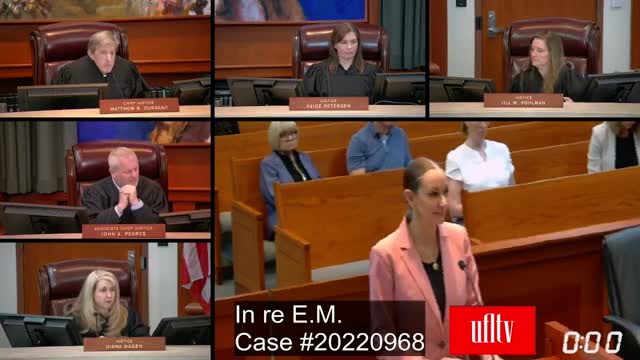Court debates juvenile transfer laws and rehabilitation prospects in high-stakes case
December 13, 2024 | Utah Appellate Court Collection, Utah Family Law District Court Collection, Utah District Courts, Utah Judicial Branch, Utah
This article was created by AI summarizing key points discussed. AI makes mistakes, so for full details and context, please refer to the video of the full meeting. Please report any errors so we can fix them. Report an error »

In a pivotal session on December 13, 2024, the Utah Supreme Court deliberated on the case of In re E.M., focusing on the critical issue of juvenile rehabilitation versus adult incarceration. The court's discussions highlighted the complexities surrounding the transfer of minors to adult court and the implications for their rehabilitation prospects.
Central to the debate was the interpretation of the statute governing juvenile transfers, particularly the burden placed on the state to demonstrate that a minor's rehabilitation is unlikely within the juvenile system. Legal representatives argued that the statute's narrow language emphasizes the need to assess the juvenile system's capacity to rehabilitate, rather than comparing it to the adult prison system. The defense contended that the juvenile system is designed specifically to treat and rehabilitate children, and transferring a minor to an adult facility could be contrary to their best interests.
The court examined the effectiveness of rehabilitation services available in both systems. Advocates for the juvenile system pointed out that minors in juvenile facilities benefit from a structured environment with a favorable staff-to-youth ratio, which significantly enhances their chances of successful rehabilitation. In contrast, they argued that adult facilities often lack adequate services, with a much higher ratio of inmates to therapists, leading to delayed access to necessary treatment.
The discussions also touched on the legislative intent behind the statute, with questions raised about the definitions of "criminal record" versus "criminal history" in the context of juvenile delinquency. The court acknowledged the potential confusion in terminology but emphasized the importance of focusing on the minor's rehabilitation needs.
As the court continues to weigh the arguments, the outcome of this case could set a significant precedent regarding how Utah handles juvenile offenders and their rehabilitation opportunities. The implications of this decision are profound, potentially affecting the future of juvenile justice in the state and the lives of countless minors navigating the legal system.
Central to the debate was the interpretation of the statute governing juvenile transfers, particularly the burden placed on the state to demonstrate that a minor's rehabilitation is unlikely within the juvenile system. Legal representatives argued that the statute's narrow language emphasizes the need to assess the juvenile system's capacity to rehabilitate, rather than comparing it to the adult prison system. The defense contended that the juvenile system is designed specifically to treat and rehabilitate children, and transferring a minor to an adult facility could be contrary to their best interests.
The court examined the effectiveness of rehabilitation services available in both systems. Advocates for the juvenile system pointed out that minors in juvenile facilities benefit from a structured environment with a favorable staff-to-youth ratio, which significantly enhances their chances of successful rehabilitation. In contrast, they argued that adult facilities often lack adequate services, with a much higher ratio of inmates to therapists, leading to delayed access to necessary treatment.
The discussions also touched on the legislative intent behind the statute, with questions raised about the definitions of "criminal record" versus "criminal history" in the context of juvenile delinquency. The court acknowledged the potential confusion in terminology but emphasized the importance of focusing on the minor's rehabilitation needs.
As the court continues to weigh the arguments, the outcome of this case could set a significant precedent regarding how Utah handles juvenile offenders and their rehabilitation opportunities. The implications of this decision are profound, potentially affecting the future of juvenile justice in the state and the lives of countless minors navigating the legal system.
View full meeting
This article is based on a recent meeting—watch the full video and explore the complete transcript for deeper insights into the discussion.
View full meeting

